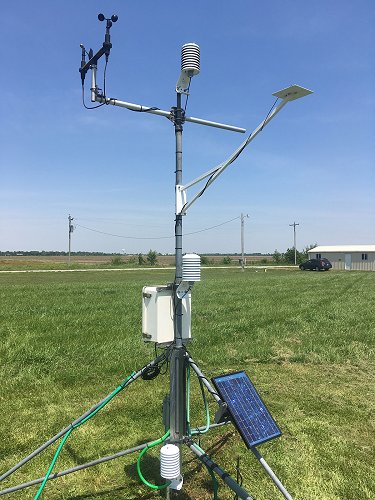
MU Extension weather stations help farmers know when to spray
Research links off-target herbicide movements to temperature inversions.
Story by: Linda Geist
July 17, 2017
COLUMBIA, Mo. – Nine Missouri weather stations recently received updates to help farmers and chemical applicators know when to spray herbicides to avoid off-target movement caused by temperature inversions.
The University of Missouri Extension Commercial Agriculture Program operates 24 real-time weather stations throughout the state. The Missouri Soybean Merchandising Council recently funded updates for stations in Monroe City, Vandalia, Albany, Columbia, Green Ridge, Hayward, Lamar, Linneus and Mountain Grove.
 |
| Nine Missouri weather stations, including this one at the Monroe City Regional Airport, recently received updates to help farmers and chemical applicators know when to spray herbicides to avoid off-target movement caused by temperature inversions. |
| Credit: Photo courtesy of Pat Guinan |
MU Plant Sciences researcher Mandy Bish says these weather stations now read air temperatures at three ground heights. MU Extension climatologist Pat Guinan and systems administrator John Travlos collaborated with Bish and MU Extension weed scientist Kevin Bradley to select and equip stations in multiple cropping districts in the state. Reports from each station feed immediately to the free Missouri Mesonet website at mesonet.missouri.edu. This information indicates whether conditions are right for temperature inversions that contribute to chemical drift.
Temperature inversions are stable air masses in which cooler air is near the earth’s surface and warmer air is on top.
Inversions are common throughout the growing season. Inversions may occur at different times of the day, but they typically start between 6 and 7 p.m. during early months and 7 to 8 p.m. in later summer.
They also happen at times when farmers may have once thought it safe to spray: when skies are clear and the wind is still.
Off-target movement of herbicides due to temperature inversions is thought to happen when herbicide particles are suspended in the stable air mass. Another possibility is that herbicide droplets may initially land on the intended target but then volatilize, or evaporate, into an inversion, Bish says.
Bish says there are four main indicators of temperature inversion: a clear night sky, wind speeds under 3 miles per hour, presence of dew or frost, and a low-lying horizontal fog.
The group recently released smoke bombs to test whether the smoke could signal that a temperature inversion was occurring.
During the recent MU Pest Management Field Day, Bish showed slides of colored smoke bombs being set off to show how particles suspend in the air. Dispersion and movement of the colored particles correlates to data from weather station data.
Bish noted that inversions are not the only possible component in herbicide drift. Volatility and physical drift due to wind, droplet size, sprayer speed and boom height can also contribute to off-target herbicide movement.
Missouri Mesonet provides real-time weather data from stations across the state. Click on the “Temperature Inversion Potential” option.
You can also watch Bish’s YouTube videos on temperature inversions at youtu.be/vDUWsdKEGYY and youtu.be/3Qce-mbqays.
Presentation slides on “Knowing When to Spray: Monitoring the Weather” are available at weedscience.missouri.edu. Select the “slideshows” link.
Original story posted here.
Source: Mandy Bish, 573-882-5908












